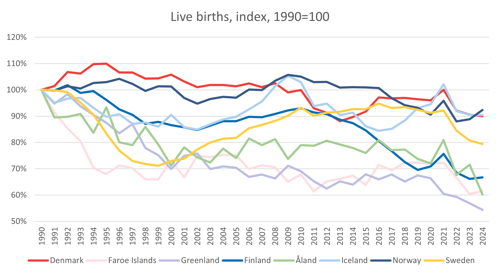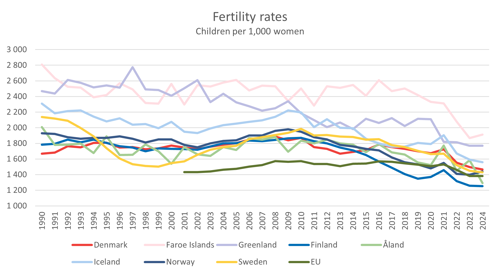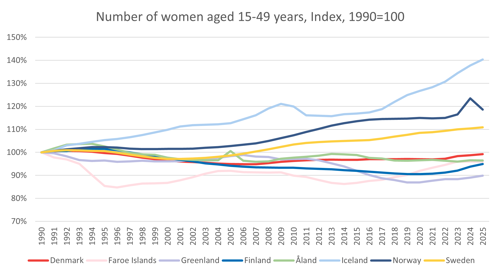Record low fertility in the Nordics
In 2024, a total of 259,000 children were born in the Nordics. This is a slight increase from 2023, when the number was record low.
The total fertility rates in the Nordics in 2024 ranged from 1.25 in Finland to 1.91 in Faroe Islands, with four countries having record low rates.
More women of childbearing age in three countries compensates somewhat for the low fertility, but in four of the countries the number of women of fertile age is also falling, which has a double effect on births.
This article looks at the developments observed for a range of indicators concerning the number of births and fertility across the Nordics.
How many children are born is determined by two things - how many women there are of fertile age and how they choose to have children (their fertility). A larger group of women of fertile age combined with low fertility can give birth to the same number of children as a smaller group of women with high fertility.
Live births
Over the past decades, the number of (live) births has decreased in all 8 Nordic countries. In 2024, a total of 259,000 children were born in the 8 Nordic countries, which is -19% compared to 1990 and only 300 children up from the record low number of 2023. At the country level, the decreases vary between -8% in Norway and -46% in Greenland.

Source: Nordic Statistics Database, CHIL01
Fertility rates
Fertility rates have steadily declined from the mid-1960s through to the turn of the century in the Nordic countries. However, at the beginning of the 2000s, the total fertility rate showed signs of rising again. This development stopped in 2010, after the financial crisis, (when the total fertility rates were between 1,83-2,50) and subsequent declines were observed.
In 2021 the fertility rates increased in most Nordic countries, coinciding with the COVID-19 pandemic, but in 2022 the trend turned downward again and in both 2023 and 2024 historic lows were reached.
Since 2010, the total fertility rates have decreased in all countries: proportionally least in Greenland (-19%, 2023 value), followed by Denmark (-22%), Faroe Islands (-24%), Norway (-26%), Sweden (-28%) and Iceland (-29%). The largest decreases can be found in Finland (-33%) and Åland (-30%). In comparison, fertility in the EU has decreased by -12% over the same period.
Worth noticing is that the countries are loosely clustered into two groups. In Greenland, Faroe Islands, and Iceland the rates have historically been higher than in the other five countries, with larger variation between the years as the population base is smaller.

Source: Nordic Statistics Database, CHIL02
In 2024, fertility rates were at record lows in Finland (1.25), Åland (1.29) [1], Iceland (1.56) and Sweden (1.43). The rates in Faroe Islands (1.91) and Norway (1.44) were marginally higher than in 2023, when record lows were reported there (1.87 and 1.40, respectively). The Danish rate is also low (1.47), although still at a higher level than in the early 1980s. [2] For Greenland, 2024 values are not yet available, but the 2023 value (1.77) was also the lowest total fertility rate reported.
The so-called replacement level is just over two children per woman, or 2,000 children per 1,000 women. This means that a woman should have two children in order for the population size to remain unchanged.
Women of fertile age
The fertility rate has declined in the Nordic countries, but that is not the only possible reason for fewer children being born. As previously stated, the number of children is determined by two things - how women choose to have children (their fertility) and how many women there are of fertile age (here 15-49 years is used).
As can be seen in the figure below, the number of fertile women has increased in the past four decades, in a number of countries. In Iceland, there are 40% more women in 2025 than in 1990. This explains why the number of live births has decreased so little (-10%) even though the total fertility rate has decreased by -32% in the same period. The same can be noted for Norway and Sweden, an increase in number of women in fertile age (by 19 and 11% compensates for the decrease in fertility (by -25 and -33%), resulting in a smaller decrease in number of births (-8 and -21%).
In Denmark, the number of women of fertile age in 2025 was almost exactly the same as in 1990 (-1%), while the fertility rate in 2024 was 12% lower than in 1990, resulting in -10% fewer births.
In Faroe Islands, Finland and Åland there were around 5% less women of fertile age in 2025 than in 1990. This reinforced the effect of the declining fertility (-32%, -30%, -36%), resulting in a larger decline in births (-38%, -33%, -40%).

Source: Nordic Statistics Database, CITI01
_________________________________________________________________
[1] 2024 values for Åland are pending, but the total fertility rate can be found at Statistics Finland https://statfin.stat.fi/PxWeb/pxweb/sv/StatFin/StatFin__synt/statfin_synt_pxt_12du.px/